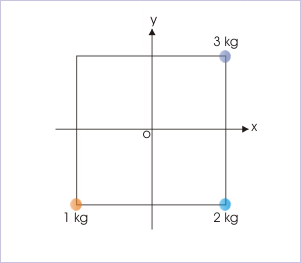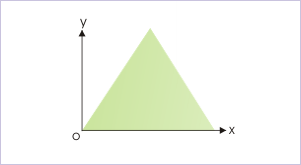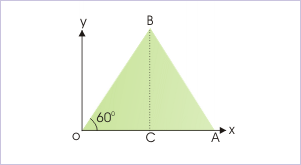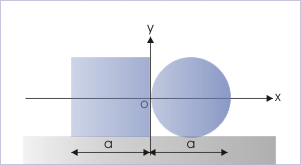| << Chapter < Page | Chapter >> Page > |
The questions have been selected to enhance understanding of the topics covered in the modules titled "Center of mass" and "Center of mass and rigid bodies". All questions are multiple choice questions with one or more correct answers. There are two sets of the questions. The “understanding level” questions seek to unravel the fundamental concepts involved, whereas “application level” are relatively difficult, which may interlink concepts from other topics.
Each of the questions is provided with solution. However, it is recommended that solutions may be seen only when your answers do not match with the ones given at the end of this module.
An equilateral triangular portion is removed from a uniform square plate as shown in the figure. The center of the mass of the plate :
Com of remaining plate

(a) shifts to quadrant I (b) shifts to quadrant II (c) shifts to quadrant III (d) does not shift
The COM of the portion removed is the geometric center of the triangle. Note here that the geometric center of the triangle coincides with the geometric center of the square - even though the triangle is asymmetrically oriented. Thus, removal of the triangular portion does not alter the COM. The COM of the remaining part of the square plate still lies at the center of the square.
Hence, option (d) is correct.
Three particles are placed at the three corners of a square as shown in the figure. What should be the mass of the particle at the remaining corner so that the COM of the system of particles lies at the center of square ?
System of particles

(a) 4 kg or 8 kg (b) 4 kg (c) 6 kg (d) Center of the square can not be COM
In order that the COM of the system of particles lies at the center, the masses of the particles on opposite corners should be equal such that masses are symmetrically distributed about the planner axes. Thus, for the given set of particle masses, the COM does not lie at the center of the square.
Hence, option (d) is correct.
The center of mass of a rigid body :
(a) coincides with geometric center.
(b) is a geometric point.
(c) lies always inside the rigid body.
(d) lies always outside the rigid body.
The center of mass coincides with geometric center when density of the rigid body is uniform. However, a rigid body can have non-uniform density as well. In that case, center of mass does not coincide with geometric center. As discussed in the text in the modules on the topic, only choice (b) is correct.
Hence, option (b) is correct.
Three particles of 1 kg, 2 kg and 3 kg are positioned at the vertices of an equilateral triangle of side 1 m as shown in the figure. The center of mass of the particle system (in meters) is :
System of particles

The height of the triangle is :
System of particles

The COM of the system of particles is :
and
Hence, option (b) is correct.
If all the particles are situated at a distance "r" from the origin of a three dimensional coordinate system, then COM of the system of particles is :
If the particles are uniformly distributed, then COM lies at the center. On the other extreme, if there is only one particle in the system, then COM lies at a linear distance "r" from the center. For other possibilities, COM should lie between these two extremes.
Hence, option (a) is correct.
The density of a rod is not constant. In which of the following situation COM can not lie at the geometric center ?
(a) Density increases from left to right for the first half and decreases from right to left for the second half
(b) Density increases from left to right
(c) Density decreases from left to right
(d) Density decreases from left to right for the first half and increases from right to left for the second half
When density increases or decreases continuously from one end to another, the COM should lie on heavier side. In these conditions, there is no possibility that the rod is balanced at the geometric center.
Hence, options (b) and (c) are correct.
A circular and a square plate are placed in contact as shown in the figure. If the material and thickness of the two plates are same, then COM of the system of bodies as measured from the point of contact is :
System of two bodies

The COMs of each body is its geometric center. They form two particles system separated by a distance "a" in x - direction. Let subscripts "s" and "c" denote square and circular plates respectively. Let "σ" be the area surface density. Then the masses are :
and
We see that the system of bodies is symmetric about x-axis, but not about y-axis. Thus, COM lies on x - axis. Now, the x-component of COM is :
Hence, option (d) is correct.
1. (d) 2. (d) 3. (b) 4. (b) 5. (a) 6. (b) and (c)
7. (d)

Notification Switch
Would you like to follow the 'Physics for k-12' conversation and receive update notifications?